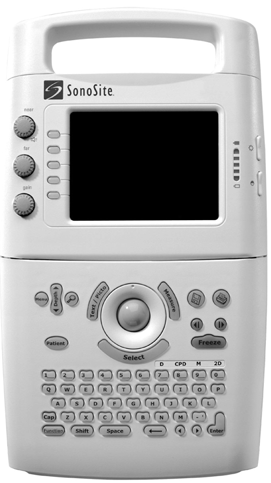Tutorial: UsTK grabber tutorial for sonosite 180 plus
Table of Contents
Introduction
This tutorial expains how to grab ultrasound images from the sonosite 180 plus connected with a BNC cable to the computer and using Visp v4l2 grabber.

The sonosite 180 plus used in our lab
Note that the source code used in this tutorial can be downloaded using the following command :
$ svn export https://github.com/lagadic/ustk.git/trunk/tutorial/ustk/sonosite
Simple grabbing and display
To grab ultrasound images from the sonosite and display them, you will need to use the ViSP v4l2 grabber, vpDisplay and multi-threading. Here is some example code :
#include <iostream>
#include <visp3/core/vpImageConvert.h>
#include <visp3/core/vpMutex.h>
#include <visp3/core/vpThread.h>
#include <visp3/core/vpTime.h>
#include <visp3/gui/vpDisplayX.h>
#include <visp3/sensor/vpV4l2Grabber.h>
#include <visp3/ustk_core/usImagePostScan2D.h>
#if defined(VISP_HAVE_V4L2) && defined(VISP_HAVE_PTHREAD)
// Shared vars
typedef enum { capture_waiting, capture_started, capture_stopped } t_CaptureState;
t_CaptureState s_capture_state = capture_waiting;
vpImage<unsigned char> s_frame;
vpMutex s_mutex_capture;
vpThread::Return captureFunction(vpThread::Args args)
{
vpV4l2Grabber cap = *((vpV4l2Grabber *)args);
vpImage<unsigned char> frame_;
bool stop_capture_ = false;
cap.open(frame_);
vpRect roi(vpImagePoint(48, 90), vpImagePoint(416, 550)); // roi to remove sonosite banners
while (!stop_capture_) {
// Capture in progress
cap.acquire(frame_, roi); // get a new frame from camera
// Update shared data
{
vpMutex::vpScopedLock lock(s_mutex_capture);
if (s_capture_state == capture_stopped)
stop_capture_ = true;
else
s_capture_state = capture_started;
s_frame = frame_;
}
}
{
vpMutex::vpScopedLock lock(s_mutex_capture);
s_capture_state = capture_stopped;
}
std::cout << "End of capture thread" << std::endl;
return 0;
}
vpThread::Return displayFunction(vpThread::Args args)
{
(void)args; // Avoid warning: unused parameter args
vpImage<unsigned char> I_;
usImagePostScan2D<unsigned char> postScan_;
t_CaptureState capture_state_;
bool display_initialized_ = false;
#if defined(VISP_HAVE_X11)
vpDisplayX *d_ = NULL;
#endif
do {
s_mutex_capture.lock();
capture_state_ = s_capture_state;
s_mutex_capture.unlock();
// Check if a frame is available
if (capture_state_ == capture_started) {
// Create a copy of the captured frame
{
vpMutex::vpScopedLock lock(s_mutex_capture);
I_ = s_frame;
}
// Convert image into post-scan image
postScan_.setData(I_);
postScan_.setProbeName("Sonosite C60");
postScan_.setTransducerRadius(0.060);
postScan_.setTransducerConvexity(true);
postScan_.setScanLineNumber(128);
postScan_.setScanLinePitch(vpMath::rad(57 / 127)); // field of view is 57 deg
// Check if we need to initialize the display with the first frame
if (!display_initialized_) {
// Initialize the display
#if defined(VISP_HAVE_X11)
d_ = new vpDisplayX(postScan_);
display_initialized_ = true;
#endif
}
// Display the image
vpDisplay::display(postScan_);
// Trigger end of acquisition with a mouse click
vpDisplay::displayText(postScan_, 10, 10, "Click to exit...", vpColor::red);
if (vpDisplay::getClick(postScan_, false)) {
vpMutex::vpScopedLock lock(s_mutex_capture);
s_capture_state = capture_stopped;
}
// Update the display
vpDisplay::flush(postScan_);
} else {
vpTime::wait(2); // Sleep 2ms
}
} while (capture_state_ != capture_stopped);
#if defined(VISP_HAVE_X11)
delete d_;
#endif
std::cout << "End of display thread" << std::endl;
return 0;
}
int main(int argc, const char *argv[])
{
unsigned int opt_input = 1; // Default value is 1 to mach the material in the lab
// Command line options
for (int i = 0; i < argc; i++) {
if (std::string(argv[i]) == "--input")
opt_input = (unsigned int)atoi(argv[i + 1]);
else if (std::string(argv[i]) == "--help") {
std::cout << "Usage: " << argv[0] << " [--input <number>] [--help]" << std::endl;
return 0;
}
}
// Instantiate the grabber
vpV4l2Grabber g;
g.setInput(opt_input);
g.setScale(1);
// Start the threads
vpThread thread_capture((vpThread::Fn)captureFunction, (vpThread::Args)&g);
vpThread thread_display((vpThread::Fn)displayFunction);
// Wait until thread ends up
thread_capture.join();
thread_display.join();
return 0;
}
#else
int main()
{
#ifndef VISP_HAVE_V4L2
std::cout << "You should enable V4L2 to make this example working..." << std::endl;
#elif !defined(_WIN32) && (defined(__unix__) || defined(__unix) || (defined(__APPLE__) && defined(__MACH__))) // UNIX
std::cout << "You should enable pthread usage and rebuild ViSP..." << std::endl;
#else
std::cout << "Multi-threading seems not supported on this platform" << std::endl;
#endif
}
#endif
void setData(const vpImage< Type > &image)
Definition: usImagePostScan2D.h:211
void setTransducerConvexity(const bool isTransducerConvex)
Definition: usTransducerSettings.cpp:189
void setScanLinePitch(const double scanLinePitch)
Definition: usTransducerSettings.cpp:171
void setProbeName(std::string probeName)
Definition: usTransducerSettings.cpp:238
void setTransducerRadius(const double transducerRadius)
Definition: usTransducerSettings.cpp:157
void setScanLineNumber(unsigned int scanLineNumber)
Definition: usTransducerSettings.cpp:222
Note that filling the probe settings (raduis, depth, fov) is important if you want to apply some processes on the image (back-scan conversion, visual servoing ...).